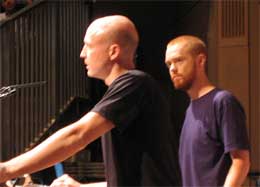 Apart from the ShiftSpace presentation, the other Pixelspaces talk i really enjoyed was by James Powderly and Evan Roth (US) from Graffiti Research Lab. They developed the project at eyebeam in New York.
Apart from the ShiftSpace presentation, the other Pixelspaces talk i really enjoyed was by James Powderly and Evan Roth (US) from Graffiti Research Lab. They developed the project at eyebeam in New York.
I didn’t get this project at all before ars electronica. I kind of read about it here and there and thought “mmmh! throwing luminous thingies at buildings? So what?” But i discovered during their talk that there’s more behind G.R.L. and i liked what i heard. A lot (though i wasn’t really convinced by the “let’s throw some luminous thingies at the tram” performance.)
My notes from their talk:
Roth explained that his fellowship at Eyebeam was based on a previous work: his thesis project at Parsons, the Graffiti Analysis system which makes visible the unseen movements of graffiti artists in the creation of a tag.
Powderly worked for a robotic company in New York and was until then thus only used to working on “leaving marks on the rocks on Mars.�
Their works has a lot to do with the hacking mentality. They don’t define themselves as graffiti artists but rather as graffiti engineers, a bit in the style of Q, the gadget guy who devised accessories for James Bond. Their work is an extension of the graffiti and aims to provide graffiti writers, street artists and protesters with new tools in order to help them take back public space and challenge corporate culture. All their work is OS, that was one of the requirements to work at Eyebeam.
They gave us an overview of the works they found most inspiring:
Zoetropes, by the Toyshop Collective, repurposed bicycle wheels animated and inspired by the zoetrope, a XIXth century device that produces an illusion of action from a rapid succession of static pictures.
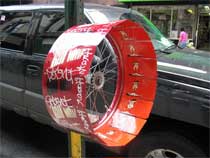
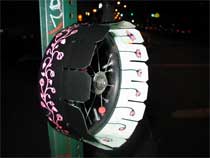 Darius Jones, a graffiti artist from Brooklyn, whose work is characterized by a perversion in the use of existing systems. He clearly has a certain eye for creating romance in unexpected places, making the city fall in love with itself. Street signs falling in love; images of the signage brought into 3D space, at street level; surveillance cameras surveilling themselves, etc.
Darius Jones, a graffiti artist from Brooklyn, whose work is characterized by a perversion in the use of existing systems. He clearly has a certain eye for creating romance in unexpected places, making the city fall in love with itself. Street signs falling in love; images of the signage brought into 3D space, at street level; surveillance cameras surveilling themselves, etc.
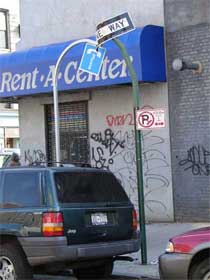
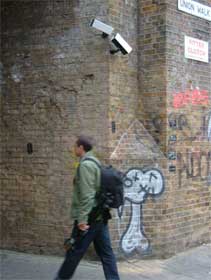 Mark Jenkins, based in Washington DC, used mostly tape as its material. He leaves his tape kids all over the city as gifts to the world.
Mark Jenkins, based in Washington DC, used mostly tape as its material. He leaves his tape kids all over the city as gifts to the world.
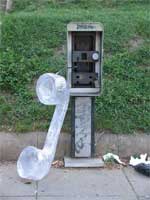
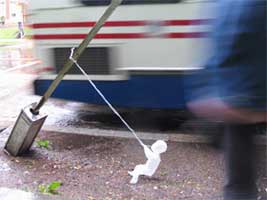
Such pieces are very temporal, they stay there only a few hours and their traces live on on the web. He ended up using LED Throwies as well (see his Jesus). His “embedded� works are a big success as well. For example his Homeless Guy makes us look back at ourselves and at how we interact with each other.
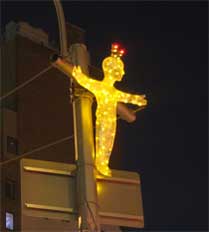
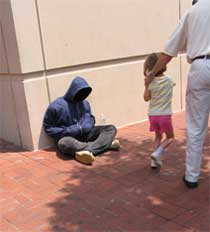
Banksy, “the exterior paint specialist�.
Both Banksy and Jenkins have taken over surveillance cameras.
“Boring�: Banksy used a fire extinguisher to paint the letters on the wall of a building because he didn’t think much of its architecture. He emptied the extinguisher and filled it with red paint.
They showed also images of Banksy’s works in zoos. The artist is known for sneaking into the penguin enclosure at London Zoo and painting ‘We’re bored of fish- We wanna go home’.
Hacks in museum (some of the pieces he hung in some museum are now listed as part of the permanent collection. “Vandalized oil paintingâ€?. GRL showed some of Banksys’s films. He tags up for a very interesting reasons. Apparently policemen wear caps that hide their eyebrows. Apparently eyebrows are such an expressive part of our face that it’s best to leave them in the shadow. But it means that policemen cannot easily see what’s up.
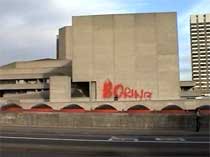
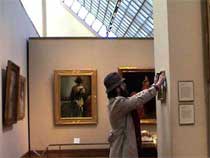
These artists have online equivalents: the Velvet Strike Team who conceptualized during the beginning of Bush’s “War on Terrorism” a collection of spray paints to use as graffiti on the walls, ceiling, and floor of the popular network shooter terrorism game “Counter-Strike”.
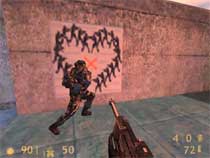
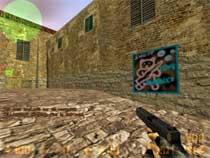
A walk series of stencils.
Graffiti artists use the web a lot to document their work. Which can lead to some problems as some of them have been arrested via their MySpace page, some have even been busted out of their MySpace page.
Now how does the work of Graffiti Research Lab fit into this?
They want to provide graffiti artists with the tools that would allow them to compete with corporate advertisers. Powderly even added that the most interesting things done using the throwies or the Night Writer have been done by others with the help of GRL sometimes (as with the Throwie Talkie, a Throwie hacked to blink graffiti messages in morse code, an idea of Pat & Ward Cunningham) but often without it. A search about throwies on google shows that it’s not about GRL anymore.
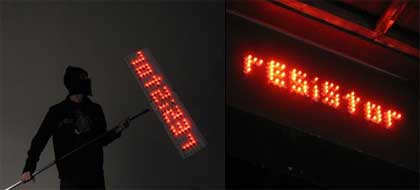 Jose Luis de Vicente asked them about their concern for the sustainability of the Throwies (each of them is equipped with a tiny battery). GRL seemed to be very concerned with the problem. They developed a solar-powered throwie but as it’s 7 times more expensive than the “regular” one, it wouldn’t be affordable enough for artists. Usually throwies do not stay in the environment as people like to throw them then they want to take them back home as a souvenir. But here again comes the problem of recycling: do we know if these people recycle the batteries correctly?
Jose Luis de Vicente asked them about their concern for the sustainability of the Throwies (each of them is equipped with a tiny battery). GRL seemed to be very concerned with the problem. They developed a solar-powered throwie but as it’s 7 times more expensive than the “regular” one, it wouldn’t be affordable enough for artists. Usually throwies do not stay in the environment as people like to throw them then they want to take them back home as a souvenir. But here again comes the problem of recycling: do we know if these people recycle the batteries correctly?
GRL gave a second talk during the Forum I – Interactive Art presentations. You can download the podcast.
Many images found on wooster collective and visual resistance.
